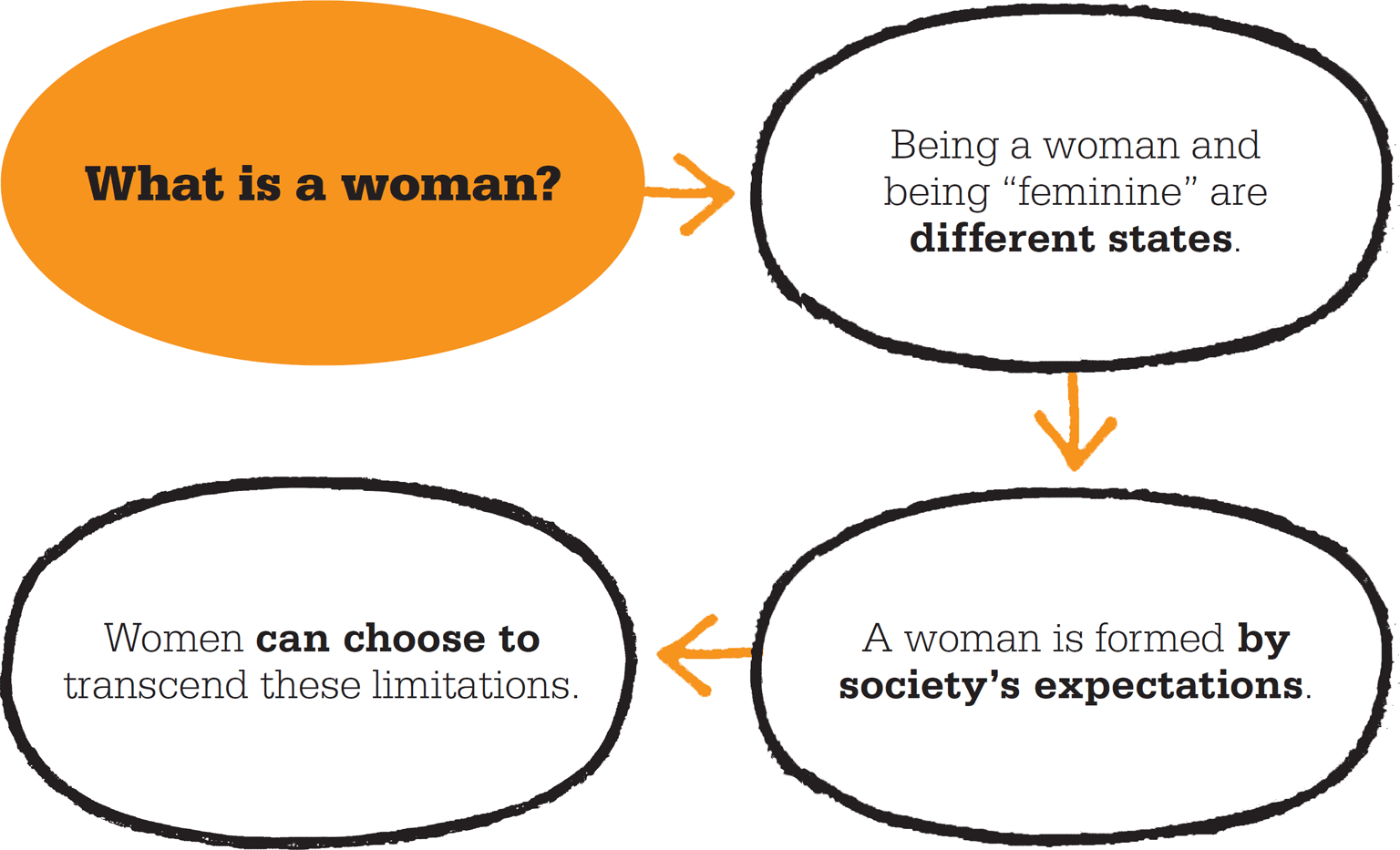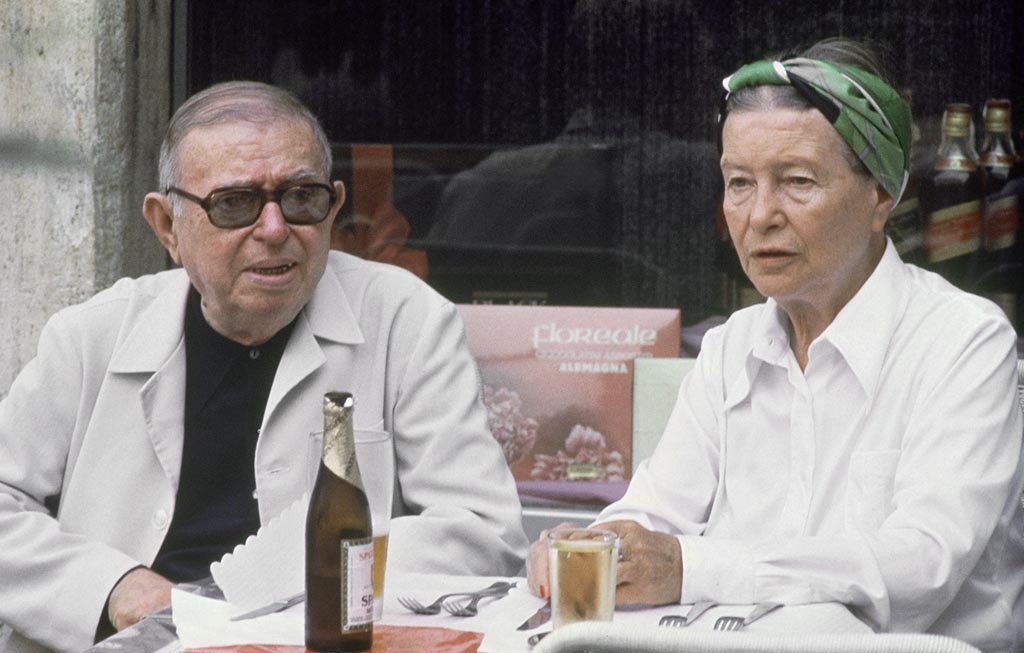
IN CONTEXT
Existentialist feminism
Freedom of choice
1791 Olympe de Gouges writes the Declaration of the Rights of Woman and the Female Citizen.
1892 Eugénie Potonié-Pierre and Léonie Rouzade found the Federation of French Feminist Societies.
1944 Women finally win the right to vote in France.
1963 Betty Friedan publishes The Feminine Mystique, bringing many of de Beauvoir’s ideas to a wider audience.
1970 In The Female Eunuch, Australian writer Germaine Greer examines the limits placed on women’s lives in consumer societies.
Across the world, women earn lower incomes than men, are frequently deprived of legal and political rights, and are subject to various forms of cultural oppression. In this context, feminist interpretations of political problems have provided an important contribution to political theory and inspired generations of political thinkers.

Throughout the 19th century, the concept of feminism had been growing in force, but there were deep conceptual divides between the various feminist groups. Some supported the concept of “equality through difference,” accepting that there are inherent differences between men and women, and that these differences constitute the strength of their positions in society. Others held the view that women should not be treated differently from men at all, and focused first and foremost on universal suffrage as their main goal, viewing equal political rights as the key battle. This battle for rights has since become known as “first-wave feminism,” to distinguish it from the “second-wave feminism” movement that had wider political aims and gathered pace around the world in the 1960s. This new movement considered women’s experience of discrimination in the home and the workplace, and the often subtle manifestations of unconsciously held prejudices that could not necessarily be fixed merely through changes in the law. It took much of its intellectual inspiration from the work of French philosopher Simone de Beauvoir.
"He is the Subject, he is the Absolute. She is the Other."
Simone de Beauvoir
Transcending feminism
Although she is sometimes described as the “mother of the modern women’s movement,” at the time of writing her seminal work The Second Sex in 1949, de Beauvoir did not view herself primarily as a “feminist.” She held ambitions to transcend this definition, which she felt often became bogged down in its own arguments. Instead, she took a more subjective approach to the concept of difference, combining feminist arguments with her existentialist philosophical outlook. However, de Beauvoir was later to join the second-wave feminist movement, and was still active in support of its arguments in the 1970s, examining the wider condition of women in society in a series of novels.
De Beauvoir realized that when she made an effort to define herself, the first phrase that came to her mind was “I am a woman.” Her need to examine this involuntary definition—and its deeper meaning—formed the basis of her work. For de Beauvoir, it is important to differentiate between the state of being female, and that of being a woman, and her work eventually alights on the definition “a human being in the feminine condition.” She rejects the theory of the “eternal feminine”—a mysterious essence of femininity—which can be used to justify inequality. In The Second Sex, she points out that the very fact that she is asking the question “What is a woman?” is significant, and highlights the inherent “Otherness” of women in society in relation to men. She was one of the first writers to fully define the concept of “sexism”in society: the prejudices and assumptions that are made about women. She also asks whether women are born, or whether they are created by society’s preconceptions, including educational expectations and religious structures, as well as historical precedents. She examines how women are represented in psychoanalysis, history, and biology, and draws on a variety of sources—literary, academic, and anecdotal—to demonstrate the effects on women of these assumptions.
De Beauvoir’s approach in answering the question “What is a woman?” is guided by her involvement with existentialism, which is essentially concerned with the discovery of the self through the freedom of personal choice within society. De Beauvoir sees women’s freedom in this regard as peculiarly restricted. This philosophical direction was reinforced by her relationship with Jean-Paul Sartre, who she met at the Sorbonne in 1929. He was a leading existentialist thinker, and they were to maintain a long and fruitful intellectual dialogue, as well as a complex and lasting personal relationship.
"What a curse to be a woman! And yet the very worst curse when one is a woman is, in fact, not to understand that it is one."
Søren Kierkegaard
De Beauvoir’s position is also informed by her left-wing political convictions. She describes women’s struggles as part of the class struggle, and recognizes that her own start in life as a member of the bourgeoisie meant that opportunities were open to her that were not available to women from the lower classes. Ultimately, she wanted such freedom of opportunity for all women—indeed all people—regardless of class.
De Beauvoir draws parallels between a woman’s physical confinement—in a “kitchen or a boudoir”—and the intellectual boundaries imposed on her. She suggests that these limitations lead women to accept mediocrity and discourage them from pushing themselves to achieve more. De Beauvoir calls this state “immanence.” By this, she means that women are limited by, and to, their own direct experience of the world. She contrasts this position with men’s “transcendence,” which allows them access to any position in life that they might choose to take, regardless of the limits of their own direct experience. In this, men are “Subjects,” who define themselves, while women are “Others,” who are defined by men.
De Beauvoir questions why women generally accept this position of “Other,” seeking to account for their submissiveness to masculine assumptions. She clearly states that immanence is not a “moral fault” on the part of women. She also acknowledges what she sees as the inherent contradiction facing women: the impossibility of choosing between herself—as a woman—as fundamentally different from a man, and herself as a totally equal member of the human race.

A woman’s traditional role as wife, homemaker, and mother traps her, according to de Beauvoir, in a place where she is cut off from other women and defined by her husband.
Freedom to choose
Many aspects of The Second Sex were highly controversial, including de Beauvoir’s frank discussion of lesbianism and her open contempt for marriage, both of which resonated deeply with her own life. She refused to marry Sartre on the principle that she did not want their relationship to be restrained by a masculine institution. For her, marriage lay at the heart of women’s subjection to men, binding them in a submissive position in society and isolating them from other members of their sex. She believed that only where women remained autonomous might they be able to rise together against their oppression. She felt that if girls were conditioned to find “a pal, a friend, a partner,” rather than “a demigod,” they could enter a relationship on a far more equal footing.
Central to de Beauvoir’s thesis is the concept, rooted in existentialism, that women can “choose” to change their position in society: “If woman discovers herself as the inessential, and never turns into the essential, it is because she does not bring about this transformation herself.” In other words, only women could liberate themselves—they could not be liberated by men. Taking responsibility for difficult choices was a core idea in de Beauvoir’s existentialism. Her own choice of relationship in the 1920s was a difficult one, involving a complete rejection of the values of her own upbringing and a disregard for social norms.
"In human society nothing is natural and woman, like much else, is a product elaborated by civilization."
Simone de Beauvoir
Some of those who read The Second Sex believed de Beauvoir was saying that women should become like men—that they should eschew the “femininity” that had been enforced on them, and with it their essential differences from men. However, her main thesis was that collaboration between men and women would eradicate the conflicts inherent in the accepted position of man as Subject and woman as Object. She explored this possibility in her relationship with Sartre, and attempted to embody in her own life many of the qualities she championed in her writing. De Beauvoir has been accused of being against motherhood, in the same way that she was against marriage. In truth, she was not anti-motherhood, but she did feel that society did not provide women with the choices to allow them to continue to work, or to have children out of wedlock. She saw how women might use maternity as a refuge—giving them a clear purpose in life—but end up feeling imprisoned by it. Above all, she stressed the importance of the existence of real choices, and of choosing honestly.

De Beauvoir maintained a long-term relationship with Jean-Paul Sartre, but the two never married. She saw their open relationship as an example of freedom of choice for a woman.
Reshaping feminist politics
It is now widely acknowledged that the first translation of The Second Sex into English failed to accurately interpret either the language or the concepts of de Beauvoir’s writing, leading many outside France to misunderstand her position. De Beauvoir herself declared in the 1980s, having been unaware for 30 years of the shortcomings of the translation, that she wished another one would be made. A revised version of the book was finally published in 2009.
The popularity of The Second Sex around the world—despite the shortcomings of the original English translation—led to it becoming a major influence on feminist thinking. De Beauvoir’s analysis of women’s role in society, and its political consequences for both men and women, struck a chord across the Western world, and was the starting point for the radical second-wave feminist movement. In 1963, US author Betty Friedan took up de Beauvoir’s argument that women’s potential was being wasted in patriarchal societies. This argument was to form the basis for feminist political thought throughout the 1960s and 70s.

De Beauvoir believed that men had the accepted position “Subject” within society, while women were classed as “Other.”
SIMONE DE BEAUVOIR

Simone Lucie-Ernestine-Marie-Bertrand de Beauvoir was born in Paris in 1908. The daughter of a wealthy family, she was educated privately and went on to study philosophy at the Sorbonne. While she was at university, she met Jean-Paul Sartre, who would go on to become her life-long companion and philosophical counterpart.
De Beauvoir openly declared her atheism when she was a teenager. Her rejection of institutions such as religion later led her to refuse to marry Sartre. Her work was inspired both by her own personal experiences in Paris, and by wider political issues such as the international growth of communism. Her interest in the latter led to several books on the subject. She also wrote a number of novels.
After Sartre’s death in 1980, de Beauvoir’s own health deteriorated. She died six years later, and was buried in the same grave.
Key works
1943 She Came To Stay
1949 The Second Sex
1954 The Mandarins
See also: Mary Wollstonecraft • Georg Hegel • John Stuart Mill • Emmeline Pankhurst • Shirin Ebadi
